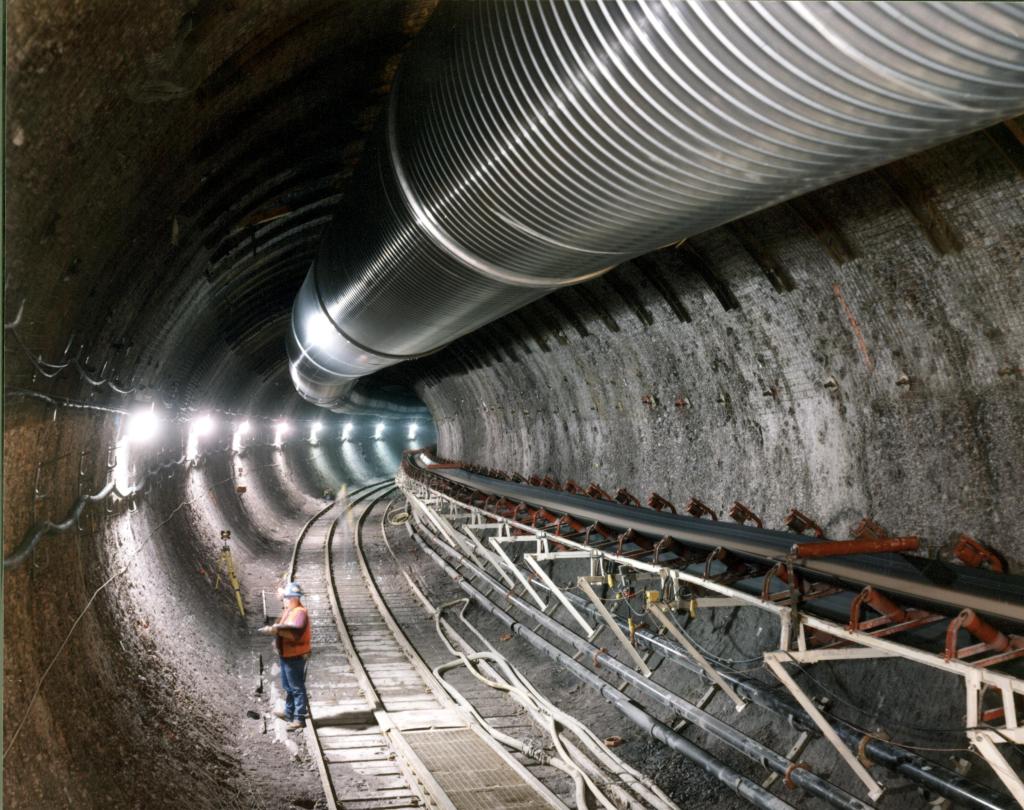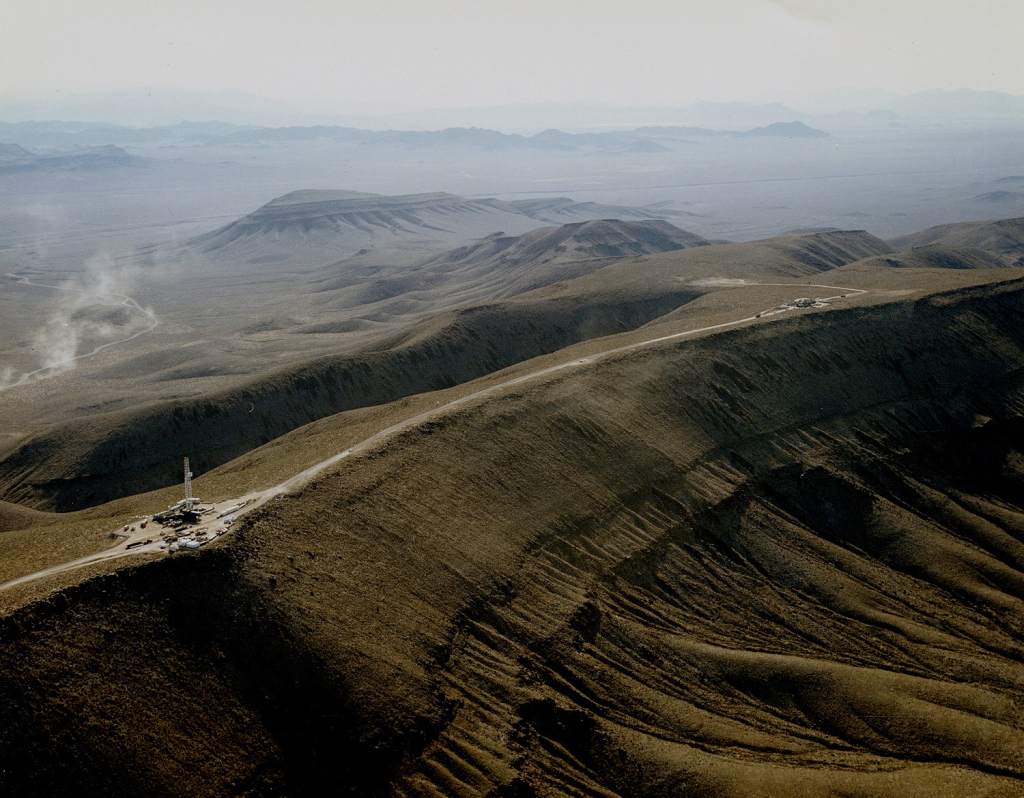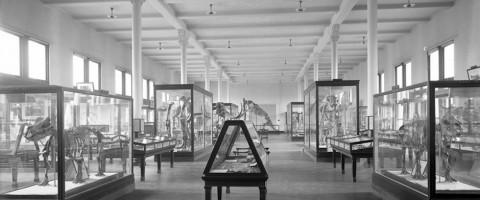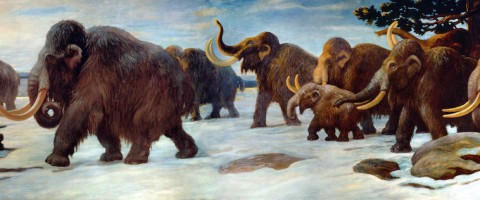Don’t change color, kitty.
Keep your color, kitty.
Stay that midnight black.
The radiation that the change implies
can kill, and that’s a fact.-Lyrics from “10,000-Year Earworm to Discourage Settlement Near Nuclear Waste Repositories”
To tell the mythology of Yucca Mountain, we might as well start with the fees. In 1983, a small fee of just a tenth of a penny per kilowatt-hour began appearing on electricity bills in America. The money was meant for Yucca Mountain, a wrinkle of land on the edge of the Nevada Test Site that was being turned into a massive tomb for the atomic age. Here, waste from nuclear power plants and weapons would be stored for at least 10,000 years until radioactivity faded to safe levels. Governments could fail and civilizations could fall, but Yucca Mountain was supposed to remain.
In 2014, after the Department of Energy had amassed $30 billion for the nuclear waste disposal fund, it quietly stopped collecting the fee. It stopped because a court told it to, because the Yucca Mountain Nuclear Waste Repository did not exist. Five miles of tunnels—out of the intended 40—had already been carved into the rock, but there was no radioactive waste stored there. After blowing past its planned opening date of January 31, 1998 by an embarrassing margin, the Obama administration in 2010 abandoned the languishing plans to build Yucca Mountain. Three-and-a-half years later, a court ruled the federal government couldn’t keep collecting fees for a site it had no intention of building.
That’s one way to see Yucca Mountain Nuclear Waste Repository’s continued nonexistence, as yet another political boondoggle: thirty billion dollars of taxpayer money collected to build a mythical mountain.
But Yucca Mountain is more than that. The ambition behind it far exceeds the two- or four- or even six-year terms of any politician. Here we were trying to build a structure that would last longer than the Great Pyramids of Egypt, longer than any man-made structure, longer than any language. When forced to adopt a long view of human existence—when looking back on today from 10,000 years into the future—it’s hard not to view Yucca Mountain in near-mythical terms. We can imagine future earthlings pondering it the way we ponder the Parthenon or Stonehenge today—massive structures imbued with an alien spirituality.
Ten thousand years may be the time scale of legends, but nuclear waste storage is a very real and practical problem for humans. It is a problem where incomprehensibly long time scales clash with human ones, where grand visions run up against forces utterly mundane and petty.

Radiation remains an almost spooky threat: an invisible, silent, and odorless danger. In contaminated sites, you see men draped in full-body suits divining for radiation with Geiger counters. To someone who did not know the purpose of this, they might resemble robed members of an atomic priesthood appealing to some invisible power.
At high enough levels, radiation sears through the body, damaging tissue in ways that are immediately obvious. At low but still dangerous levels, you can’t feel, hear, or see radiation passing through you, but it may knock loose a strand of DNA, creating a mutation that gets copied over and over in dividing cells until the day one of those cells becomes cancerous. It bides its time like a curse that can take years or decades to manifest.
In 1981, the Department of Energy convened a task force on how to communicate with the future.
The panel of consulted experts included engineers, but also an archeologist, a linguist, and an expert in nonverbal communication. Dubbed the Human Interference Task Force, they were tasked with figuring out how to keep future humans away from a deep geological repository of nuclear waste—like Yucca Mountain.
The repository would need some kind of physical marker that, foremost, could last 10,000 years, so the task force’s report considers the relative merits of different materials like metal, concrete, and plastic. Yet the marker would also need to repel rather than attract humans—setting it apart from Stonehenge, the Great Pyramids, or any other monument that has remained standing for thousands of years. To do that, the marker would need warnings. But how do you warn future humans whose cultures and languages will have evolved in unknown ways?
In addition to the physical marker, the task force recommends “oral transmission” to preserve their warning for future generations. Even as language itself mutates, the argument goes, the stories we tell endure. Imagine Homer’s epics or Beowulf, but on an even longer time scale. The report, in characteristically dry language, imagines that the future population around Yucca Mountain might tell stories that “include perpetuation of knowledge about a ‘special’ place.”
Thomas Sebeok, the linguist consulted by the Human Interference Task Force, goes into further detail in a separate report. He proposes seeding and nurturing a body of folklore around Yucca Mountain, and even inventing annual rituals where these stories could be retold. These folktales need not explain the science of radiation; they simply need to hint at a great danger.
“The actual ‘truth’ would be entrusted exclusively to—what we might call for dramatic emphasis—an ‘atomic priesthood,’” Sebeok writes. This group, he says, would need to include “a commission of knowledgeable physicists, experts in radiation sickness, anthropologists, linguists, psychologists, semioticians, and whatever additional expertise may be called for now and in the future.”
In the decades when Yucca Mountain was still under development, some of the most intense interest in the repository came from 800 miles up the West Coast in Hanford, Washington. The Hanford Nuclear Reservation produced nearly all of the plutonium that went into the U.S.’s nuclear arsenal during the Cold War. Then, it was decommissioned. Now, it is the site of the largest environmental cleanup project in the country.
Fifty-six million gallons of radioactive waste sit in 177 steel tanks buried underground. The waste ranges from soupy to sludgy, and it has the unfortunate habit of leaking out of the aging tanks into the groundwater.
This wasn’t the plan, of course. The idea was to build a vitrification plant on site, where radioactive waste could be mixed with molten glass and poured into steel columns—making the impermeable nuclear coffins that would then be entombed in Yucca Mountain. But the cleanup at Hanford has been horribly mismanaged. The vitrification plant, due to open in 2011, is still half complete. Of course, even if we manage to safely solidify and seal the radioactive waste at Hanford, we still don’t have anywhere to put it.
Meanwhile, the radioactive waste keeps leaking.
Go back down the West Coast from Hanford, head inland for 200 miles, and you’ll hit Carlsbad, New Mexico, home to the Waste Isolation Pilot Plant (WIPP), a nuclear waste repository in the deserts of the Southwest that was actually built.
Unlike Yucca Mountain, though, WIPP is only designed to handle low-level waste. While it can lock away the stuff that has come in contact with radioactive material, it can’t safely store the byproducts of nuclear reactors themselves. Gloves, tools, and other equipment used to handle plutonium and uranium are packed in drums, which are then stored in rooms tunneled into the natural salt deposit. Over time, the salt will ooze around the barrels, encasing the waste in a mineral tomb.
The problem of long-term waste storage at WIPP is real but still theoretical. It’s only when WIPP is shut down and sealed off that the plan to warn away future humans will be set in motion. For now, the tentative design is a series of 25 foot-tall granite monuments engraved with warnings in seven languages.
But, like Yucca Mountain, WIPP has been the subject of many more fantastical and evocative proposals. In 1991, it too convened a multidisciplinary panel to study the problem of communicating with the future. The resulting report laid out proposals that ranged from an architect’s “landscape of thorns” to a warning message that begins like this:
This place is a message…and part of a system of messages…pay attention to it!
Sending this message was important to us. We considered ourselves to be a powerful culture.
This place is not a place of honor…no highly esteemed deed is commemorated here…nothing valued is here.
What is here is dangerous and repulsive to us. This message is a warning about danger.

In February, a drum of radioactive waste at WIPP ruptured underground causing radioactive material to snake its way up a ventilation shaft and expose 21 workers on the surface 2,000 feet above the drum. WIPP has since shut down and may not reopen for years.
With Yucca Mountain gone, the Department of Energy had actually considered sending Hanford’s to-be-vitrified high-level waste down to WIPP. This plan clearly wasn’t going to happen either.
How can a drum just rupture? The official investigation points to a chemical reaction between nitric acid and trace metals in the drum. But this reaction only happens at high temperatures, which has cast suspicion on one other component in the drums: kitty litter.
Kitty litter is routinely used to help stabilize radioactive waste, but a contractor had recently switched from using a plastic-based litter to a wheat-based one. The rotting wheat may have created just enough heat to set off the chemical reaction that ruptured the drum.
In 1984, the German journal Zeitschrift für Semiotik (Journal of Semiotics) published a dozen responses from academics speculating on how to communicate across 10,000 years. The proposals range from the mundane to the bizarre and fantastical. One respondent proposes making the storage barrels impossible to open without great technical skill. Another involves creating a series of warnings in concentric circles that would expand as languages evolve. Thomas Sebeok is in there, elaborating on his system of rituals around an atomic priesthood and their rituals. But a pair of semioticians, Françoise Bastide and Paolo Fabbri, take the germ of Sebeok’s idea for a nuclear folklore to a singularly strange conclusion.
Their solution is “ray cats,” creatures bred to change color in the presence of radiation—like walking, purring, yarn-chasing Geiger counters. But this is just the first part of the proposal. Alongside the cats, Bastide and Fabbri propose that we invent a body of folklore, passed on through proverbs and myths to explain that when a cat changes color, you better run.
Still more wonderful and unexpected is that someone has taken Bastide and Fabbri at their word and actually written a song about ray cats. The podcast 99% Invisible commissioned Berlin-based artist Chad Matheny, aka Emperor X, to compose a “10,000-Year Earworm to Discourage Settlement Near Nuclear Waste Repositories” for an episode on nuclear waste. The song, writes Matheny, had to be “so catchy and annoying that it might be handed down from generation to generation over a span of 10,000 years.”
Ray cats may not exist. A ten thousand year nuclear waste repository at Yucca Mountain may not exist. But a song about them does.
There are no fantastical creatures at Hanford, but there are rabbits and pigeons and swallows and tumbleweeds. The security buffer around the operating Hanford Nuclear Reservation has since been converted into a national monument untouched by agriculture and development. It’s a lovely place to go hiking.
But to Hanford’s Biological Control Program, the wildlife are potential “biological radiological vectors,” and therefore represent a huge nuisance. Rabbits, badgers, and gophers that somehow ingest leaked radioactive material can spread their radioactive poop across thousands of acres. The radioactive creatures have to be hunted down, and their poop safely cleaned up by people in suits. Even tiny termites and ants can unearth radioactive material.
And then there are tumbleweeds, whose taproots can reach 20 feet down to suck up buried radioactive waste. In the winter, those taproots wither, and it’s off the tumbleweeds go, tumbling miles away with the wind. In 2010, Hanford had to chase down 30 radioactive weeds.
Someday, our nuclear waste might actually be sealed off in a mountain capped with a giant monument warning future humans 10,000 years into the future. But for now, tumbleweeds—that casual symbol of tedium—keep tumbling away with our intractable nuclear waste.



